QAM5034: Organisational Development and Change Report on Businesses
VerifiedAdded on 2022/10/09
|13
|4076
|44
Report
AI Summary
This report delves into the field of Organizational Development and Change (ODC), examining its application in addressing real-life business challenges. It begins with an introduction to ODC, highlighting its significance in helping organizations adapt to internal and external changes. The report then presents case studies of General Motors (GM), Nokia, and Coca-Cola, analyzing the issues they faced, such as failure to develop key competencies and behaviors. To resolve these issues, the report applies various change management models, including Lewin's change model, the Action Research Model, and the Positive Model. It outlines the steps involved in each model and how they can be used to facilitate organizational change. The report also discusses the processes of organizational development and change, including entering and contracting, diagnosing organizations, gathering data, providing feedback, and implementing OD interventions. The report concludes by emphasizing the importance of ODC in helping businesses achieve their objectives and adapt to a dynamic environment. The data for this report has been collected from journal articles, websites, and books.
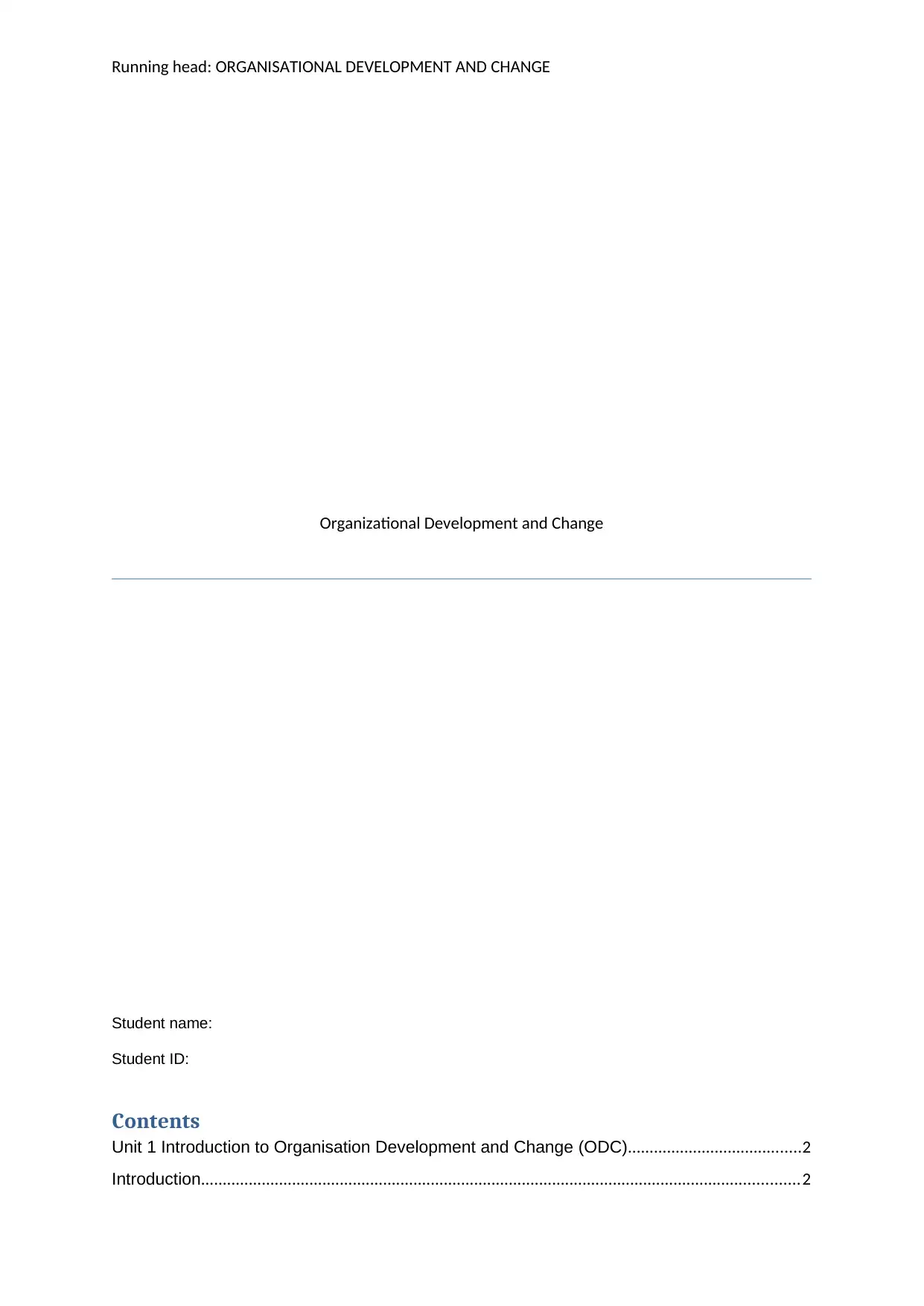
Running head: ORGANISATIONAL DEVELOPMENT AND CHANGE
Organizational Development and Change
Student name:
Student ID:
Contents
Unit 1 Introduction to Organisation Development and Change (ODC)........................................2
Introduction..........................................................................................................................................2
Organizational Development and Change
Student name:
Student ID:
Contents
Unit 1 Introduction to Organisation Development and Change (ODC)........................................2
Introduction..........................................................................................................................................2
Paraphrase This Document
Need a fresh take? Get an instant paraphrase of this document with our AI Paraphraser
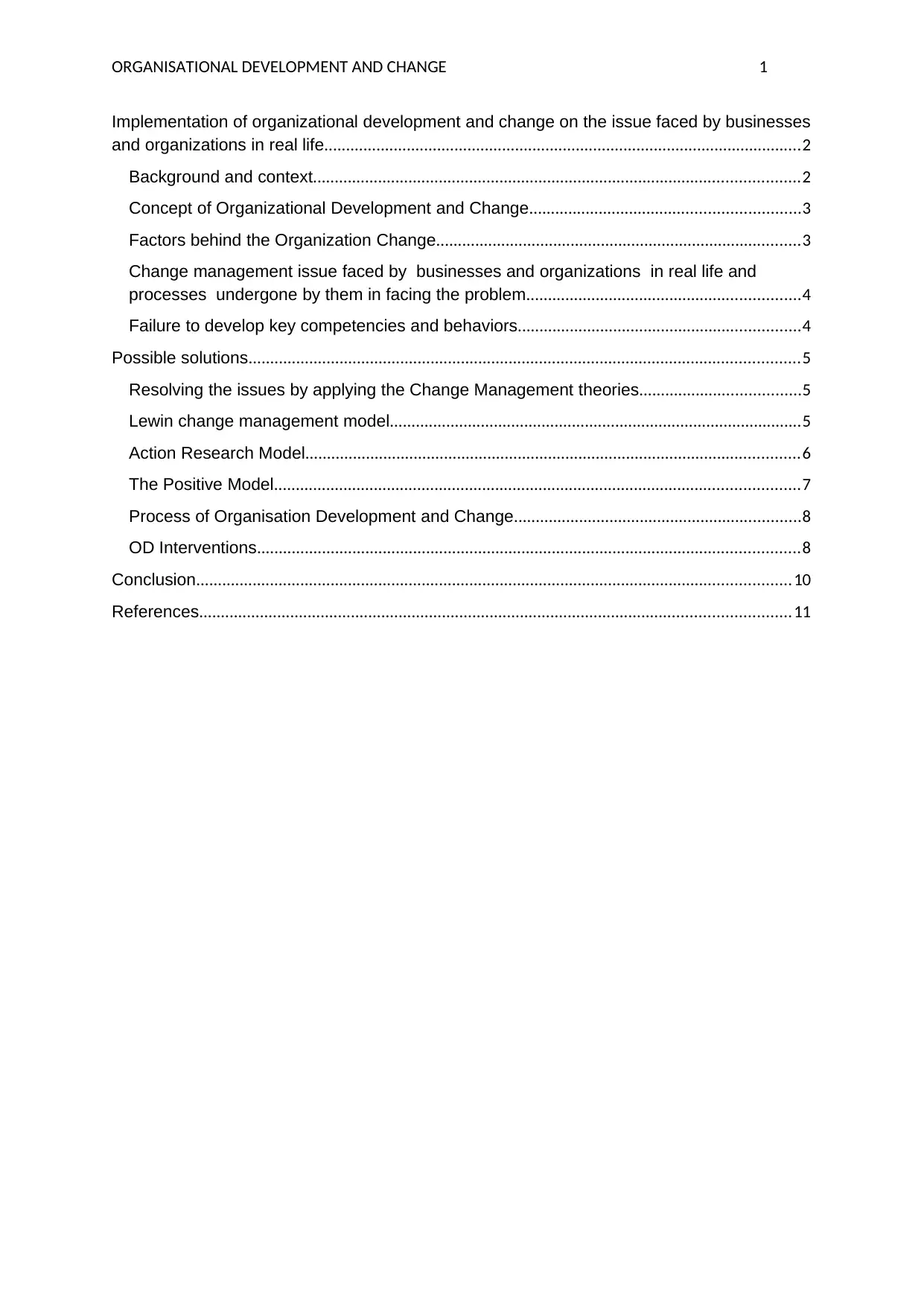
ORGANISATIONAL DEVELOPMENT AND CHANGE 1
Implementation of organizational development and change on the issue faced by businesses
and organizations in real life..............................................................................................................2
Background and context................................................................................................................2
Concept of Organizational Development and Change..............................................................3
Factors behind the Organization Change....................................................................................3
Change management issue faced by businesses and organizations in real life and
processes undergone by them in facing the problem...............................................................4
Failure to develop key competencies and behaviors.................................................................4
Possible solutions...............................................................................................................................5
Resolving the issues by applying the Change Management theories.....................................5
Lewin change management model...............................................................................................5
Action Research Model..................................................................................................................6
The Positive Model.........................................................................................................................7
Process of Organisation Development and Change..................................................................8
OD Interventions.............................................................................................................................8
Conclusion.........................................................................................................................................10
References........................................................................................................................................11
Implementation of organizational development and change on the issue faced by businesses
and organizations in real life..............................................................................................................2
Background and context................................................................................................................2
Concept of Organizational Development and Change..............................................................3
Factors behind the Organization Change....................................................................................3
Change management issue faced by businesses and organizations in real life and
processes undergone by them in facing the problem...............................................................4
Failure to develop key competencies and behaviors.................................................................4
Possible solutions...............................................................................................................................5
Resolving the issues by applying the Change Management theories.....................................5
Lewin change management model...............................................................................................5
Action Research Model..................................................................................................................6
The Positive Model.........................................................................................................................7
Process of Organisation Development and Change..................................................................8
OD Interventions.............................................................................................................................8
Conclusion.........................................................................................................................................10
References........................................................................................................................................11
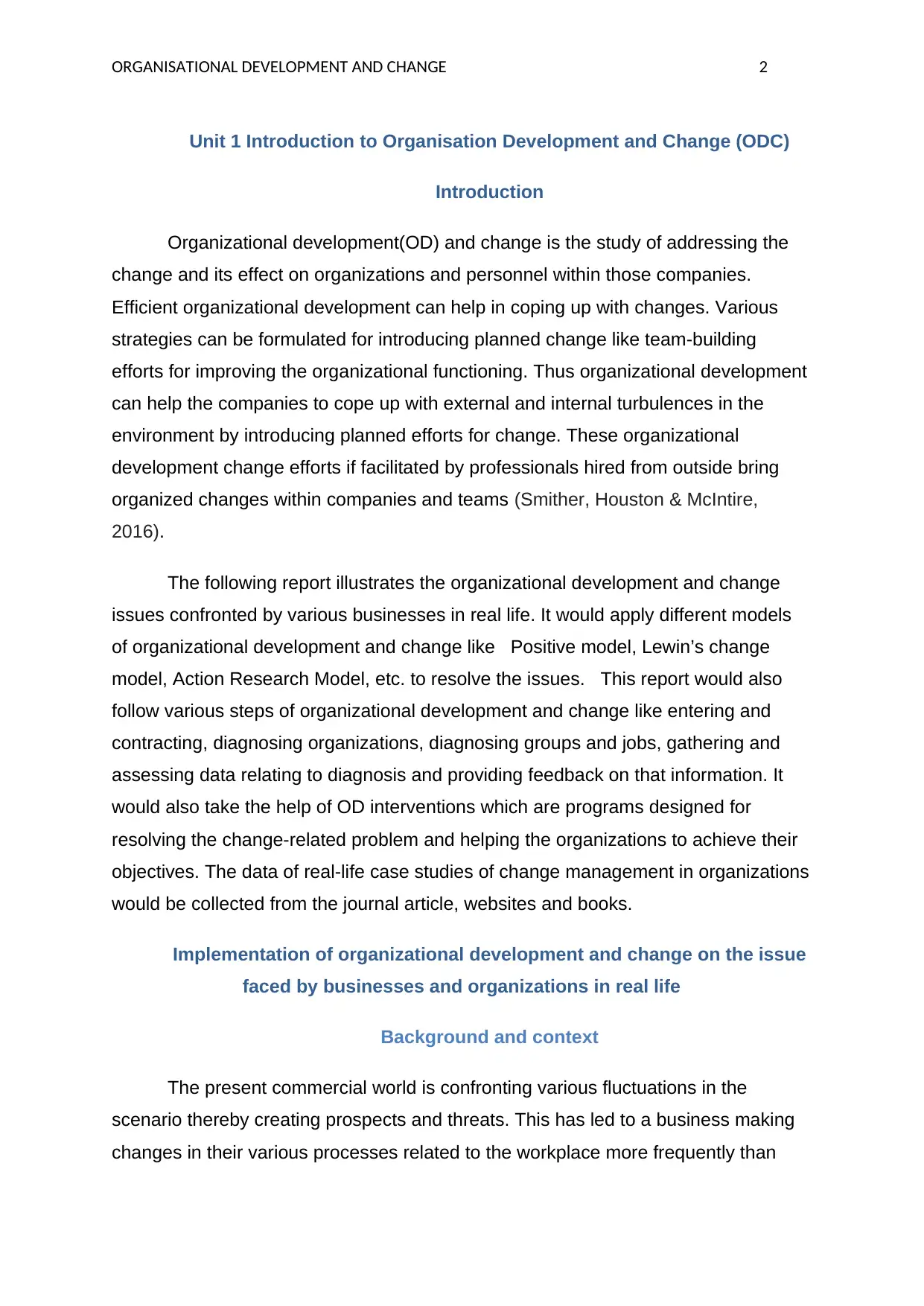
ORGANISATIONAL DEVELOPMENT AND CHANGE 2
Unit 1 Introduction to Organisation Development and Change (ODC)
Introduction
Organizational development(OD) and change is the study of addressing the
change and its effect on organizations and personnel within those companies.
Efficient organizational development can help in coping up with changes. Various
strategies can be formulated for introducing planned change like team-building
efforts for improving the organizational functioning. Thus organizational development
can help the companies to cope up with external and internal turbulences in the
environment by introducing planned efforts for change. These organizational
development change efforts if facilitated by professionals hired from outside bring
organized changes within companies and teams (Smither, Houston & McIntire,
2016).
The following report illustrates the organizational development and change
issues confronted by various businesses in real life. It would apply different models
of organizational development and change like Positive model, Lewin’s change
model, Action Research Model, etc. to resolve the issues. This report would also
follow various steps of organizational development and change like entering and
contracting, diagnosing organizations, diagnosing groups and jobs, gathering and
assessing data relating to diagnosis and providing feedback on that information. It
would also take the help of OD interventions which are programs designed for
resolving the change-related problem and helping the organizations to achieve their
objectives. The data of real-life case studies of change management in organizations
would be collected from the journal article, websites and books.
Implementation of organizational development and change on the issue
faced by businesses and organizations in real life
Background and context
The present commercial world is confronting various fluctuations in the
scenario thereby creating prospects and threats. This has led to a business making
changes in their various processes related to the workplace more frequently than
Unit 1 Introduction to Organisation Development and Change (ODC)
Introduction
Organizational development(OD) and change is the study of addressing the
change and its effect on organizations and personnel within those companies.
Efficient organizational development can help in coping up with changes. Various
strategies can be formulated for introducing planned change like team-building
efforts for improving the organizational functioning. Thus organizational development
can help the companies to cope up with external and internal turbulences in the
environment by introducing planned efforts for change. These organizational
development change efforts if facilitated by professionals hired from outside bring
organized changes within companies and teams (Smither, Houston & McIntire,
2016).
The following report illustrates the organizational development and change
issues confronted by various businesses in real life. It would apply different models
of organizational development and change like Positive model, Lewin’s change
model, Action Research Model, etc. to resolve the issues. This report would also
follow various steps of organizational development and change like entering and
contracting, diagnosing organizations, diagnosing groups and jobs, gathering and
assessing data relating to diagnosis and providing feedback on that information. It
would also take the help of OD interventions which are programs designed for
resolving the change-related problem and helping the organizations to achieve their
objectives. The data of real-life case studies of change management in organizations
would be collected from the journal article, websites and books.
Implementation of organizational development and change on the issue
faced by businesses and organizations in real life
Background and context
The present commercial world is confronting various fluctuations in the
scenario thereby creating prospects and threats. This has led to a business making
changes in their various processes related to the workplace more frequently than
⊘ This is a preview!⊘
Do you want full access?
Subscribe today to unlock all pages.

Trusted by 1+ million students worldwide
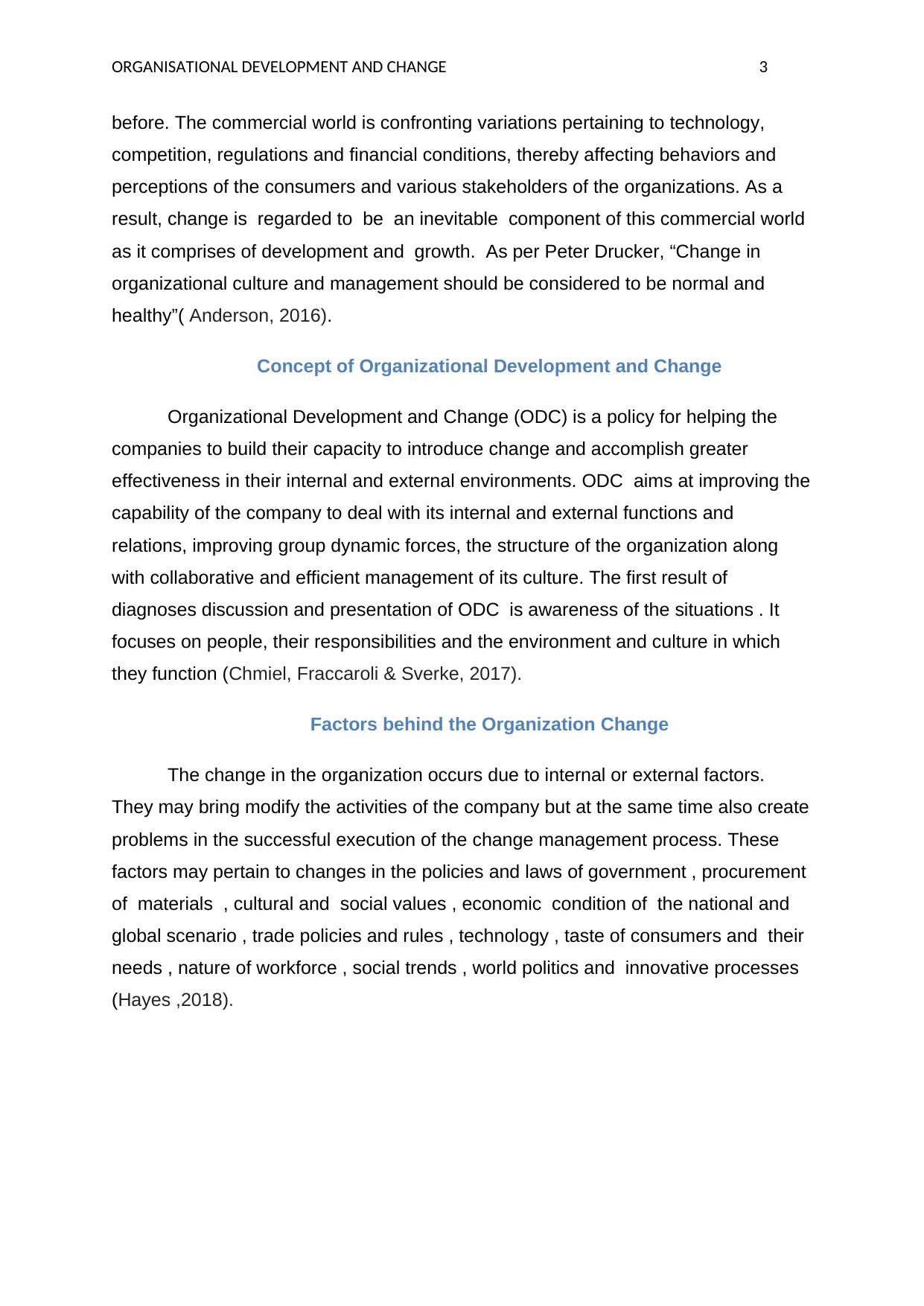
ORGANISATIONAL DEVELOPMENT AND CHANGE 3
before. The commercial world is confronting variations pertaining to technology,
competition, regulations and financial conditions, thereby affecting behaviors and
perceptions of the consumers and various stakeholders of the organizations. As a
result, change is regarded to be an inevitable component of this commercial world
as it comprises of development and growth. As per Peter Drucker, “Change in
organizational culture and management should be considered to be normal and
healthy”( Anderson, 2016).
Concept of Organizational Development and Change
Organizational Development and Change (ODC) is a policy for helping the
companies to build their capacity to introduce change and accomplish greater
effectiveness in their internal and external environments. ODC aims at improving the
capability of the company to deal with its internal and external functions and
relations, improving group dynamic forces, the structure of the organization along
with collaborative and efficient management of its culture. The first result of
diagnoses discussion and presentation of ODC is awareness of the situations . It
focuses on people, their responsibilities and the environment and culture in which
they function (Chmiel, Fraccaroli & Sverke, 2017).
Factors behind the Organization Change
The change in the organization occurs due to internal or external factors.
They may bring modify the activities of the company but at the same time also create
problems in the successful execution of the change management process. These
factors may pertain to changes in the policies and laws of government , procurement
of materials , cultural and social values , economic condition of the national and
global scenario , trade policies and rules , technology , taste of consumers and their
needs , nature of workforce , social trends , world politics and innovative processes
(Hayes ,2018).
before. The commercial world is confronting variations pertaining to technology,
competition, regulations and financial conditions, thereby affecting behaviors and
perceptions of the consumers and various stakeholders of the organizations. As a
result, change is regarded to be an inevitable component of this commercial world
as it comprises of development and growth. As per Peter Drucker, “Change in
organizational culture and management should be considered to be normal and
healthy”( Anderson, 2016).
Concept of Organizational Development and Change
Organizational Development and Change (ODC) is a policy for helping the
companies to build their capacity to introduce change and accomplish greater
effectiveness in their internal and external environments. ODC aims at improving the
capability of the company to deal with its internal and external functions and
relations, improving group dynamic forces, the structure of the organization along
with collaborative and efficient management of its culture. The first result of
diagnoses discussion and presentation of ODC is awareness of the situations . It
focuses on people, their responsibilities and the environment and culture in which
they function (Chmiel, Fraccaroli & Sverke, 2017).
Factors behind the Organization Change
The change in the organization occurs due to internal or external factors.
They may bring modify the activities of the company but at the same time also create
problems in the successful execution of the change management process. These
factors may pertain to changes in the policies and laws of government , procurement
of materials , cultural and social values , economic condition of the national and
global scenario , trade policies and rules , technology , taste of consumers and their
needs , nature of workforce , social trends , world politics and innovative processes
(Hayes ,2018).
Paraphrase This Document
Need a fresh take? Get an instant paraphrase of this document with our AI Paraphraser
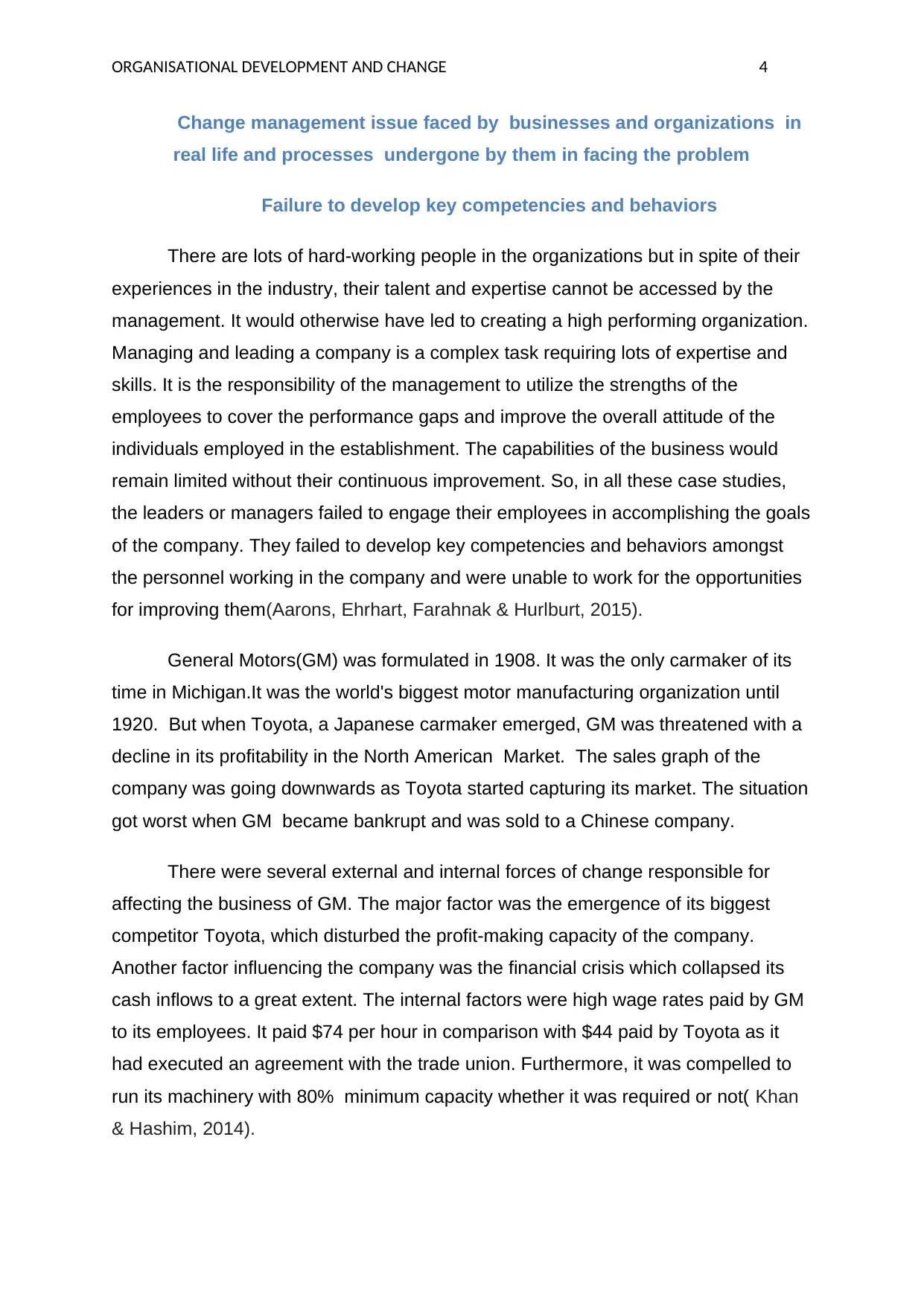
ORGANISATIONAL DEVELOPMENT AND CHANGE 4
Change management issue faced by businesses and organizations in
real life and processes undergone by them in facing the problem
Failure to develop key competencies and behaviors
There are lots of hard-working people in the organizations but in spite of their
experiences in the industry, their talent and expertise cannot be accessed by the
management. It would otherwise have led to creating a high performing organization.
Managing and leading a company is a complex task requiring lots of expertise and
skills. It is the responsibility of the management to utilize the strengths of the
employees to cover the performance gaps and improve the overall attitude of the
individuals employed in the establishment. The capabilities of the business would
remain limited without their continuous improvement. So, in all these case studies,
the leaders or managers failed to engage their employees in accomplishing the goals
of the company. They failed to develop key competencies and behaviors amongst
the personnel working in the company and were unable to work for the opportunities
for improving them(Aarons, Ehrhart, Farahnak & Hurlburt, 2015).
General Motors(GM) was formulated in 1908. It was the only carmaker of its
time in Michigan.It was the world's biggest motor manufacturing organization until
1920. But when Toyota, a Japanese carmaker emerged, GM was threatened with a
decline in its profitability in the North American Market. The sales graph of the
company was going downwards as Toyota started capturing its market. The situation
got worst when GM became bankrupt and was sold to a Chinese company.
There were several external and internal forces of change responsible for
affecting the business of GM. The major factor was the emergence of its biggest
competitor Toyota, which disturbed the profit-making capacity of the company.
Another factor influencing the company was the financial crisis which collapsed its
cash inflows to a great extent. The internal factors were high wage rates paid by GM
to its employees. It paid $74 per hour in comparison with $44 paid by Toyota as it
had executed an agreement with the trade union. Furthermore, it was compelled to
run its machinery with 80% minimum capacity whether it was required or not( Khan
& Hashim, 2014).
Change management issue faced by businesses and organizations in
real life and processes undergone by them in facing the problem
Failure to develop key competencies and behaviors
There are lots of hard-working people in the organizations but in spite of their
experiences in the industry, their talent and expertise cannot be accessed by the
management. It would otherwise have led to creating a high performing organization.
Managing and leading a company is a complex task requiring lots of expertise and
skills. It is the responsibility of the management to utilize the strengths of the
employees to cover the performance gaps and improve the overall attitude of the
individuals employed in the establishment. The capabilities of the business would
remain limited without their continuous improvement. So, in all these case studies,
the leaders or managers failed to engage their employees in accomplishing the goals
of the company. They failed to develop key competencies and behaviors amongst
the personnel working in the company and were unable to work for the opportunities
for improving them(Aarons, Ehrhart, Farahnak & Hurlburt, 2015).
General Motors(GM) was formulated in 1908. It was the only carmaker of its
time in Michigan.It was the world's biggest motor manufacturing organization until
1920. But when Toyota, a Japanese carmaker emerged, GM was threatened with a
decline in its profitability in the North American Market. The sales graph of the
company was going downwards as Toyota started capturing its market. The situation
got worst when GM became bankrupt and was sold to a Chinese company.
There were several external and internal forces of change responsible for
affecting the business of GM. The major factor was the emergence of its biggest
competitor Toyota, which disturbed the profit-making capacity of the company.
Another factor influencing the company was the financial crisis which collapsed its
cash inflows to a great extent. The internal factors were high wage rates paid by GM
to its employees. It paid $74 per hour in comparison with $44 paid by Toyota as it
had executed an agreement with the trade union. Furthermore, it was compelled to
run its machinery with 80% minimum capacity whether it was required or not( Khan
& Hashim, 2014).
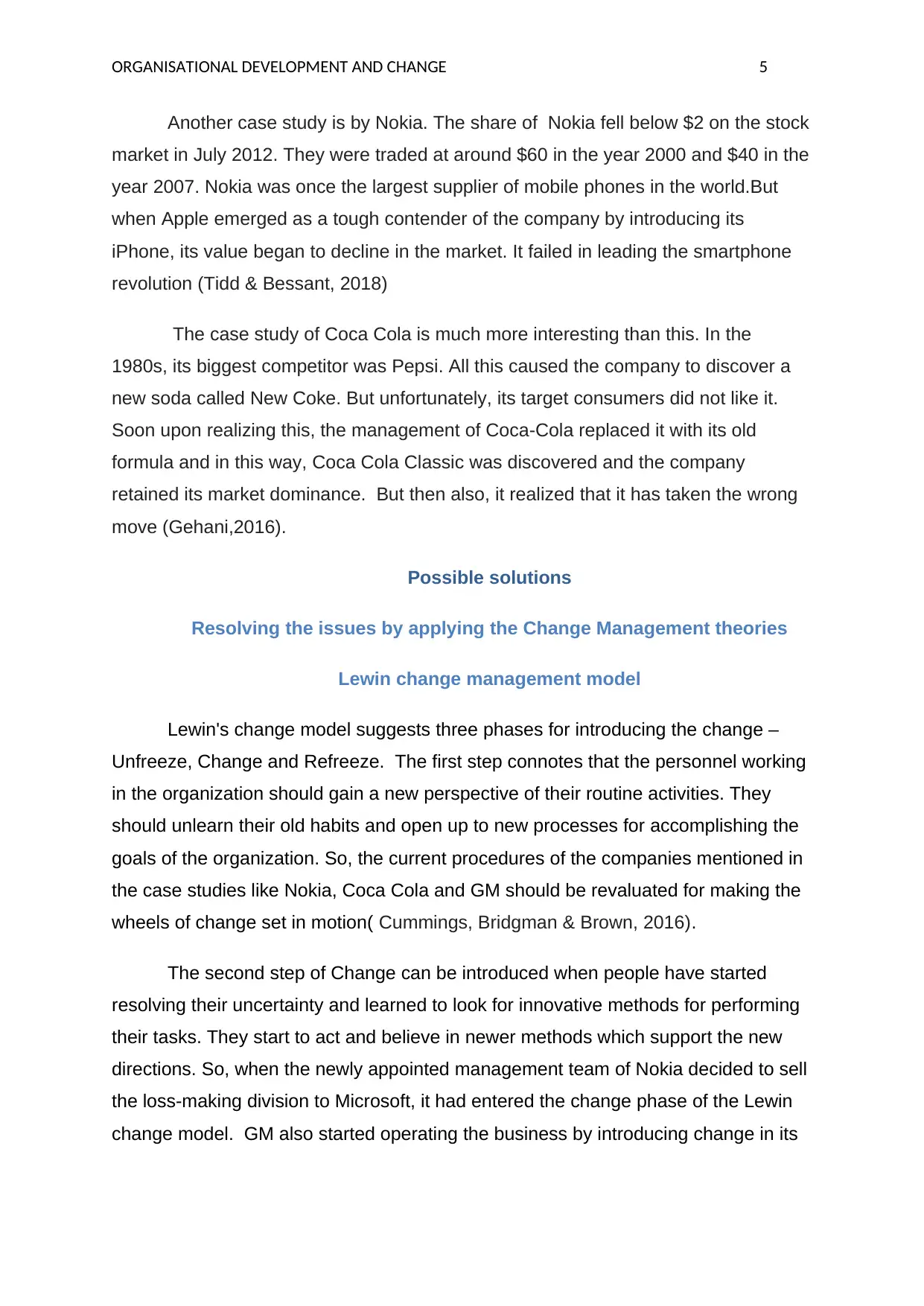
ORGANISATIONAL DEVELOPMENT AND CHANGE 5
Another case study is by Nokia. The share of Nokia fell below $2 on the stock
market in July 2012. They were traded at around $60 in the year 2000 and $40 in the
year 2007. Nokia was once the largest supplier of mobile phones in the world.But
when Apple emerged as a tough contender of the company by introducing its
iPhone, its value began to decline in the market. It failed in leading the smartphone
revolution (Tidd & Bessant, 2018)
The case study of Coca Cola is much more interesting than this. In the
1980s, its biggest competitor was Pepsi. All this caused the company to discover a
new soda called New Coke. But unfortunately, its target consumers did not like it.
Soon upon realizing this, the management of Coca-Cola replaced it with its old
formula and in this way, Coca Cola Classic was discovered and the company
retained its market dominance. But then also, it realized that it has taken the wrong
move (Gehani,2016).
Possible solutions
Resolving the issues by applying the Change Management theories
Lewin change management model
Lewin's change model suggests three phases for introducing the change –
Unfreeze, Change and Refreeze. The first step connotes that the personnel working
in the organization should gain a new perspective of their routine activities. They
should unlearn their old habits and open up to new processes for accomplishing the
goals of the organization. So, the current procedures of the companies mentioned in
the case studies like Nokia, Coca Cola and GM should be revaluated for making the
wheels of change set in motion( Cummings, Bridgman & Brown, 2016).
The second step of Change can be introduced when people have started
resolving their uncertainty and learned to look for innovative methods for performing
their tasks. They start to act and believe in newer methods which support the new
directions. So, when the newly appointed management team of Nokia decided to sell
the loss-making division to Microsoft, it had entered the change phase of the Lewin
change model. GM also started operating the business by introducing change in its
Another case study is by Nokia. The share of Nokia fell below $2 on the stock
market in July 2012. They were traded at around $60 in the year 2000 and $40 in the
year 2007. Nokia was once the largest supplier of mobile phones in the world.But
when Apple emerged as a tough contender of the company by introducing its
iPhone, its value began to decline in the market. It failed in leading the smartphone
revolution (Tidd & Bessant, 2018)
The case study of Coca Cola is much more interesting than this. In the
1980s, its biggest competitor was Pepsi. All this caused the company to discover a
new soda called New Coke. But unfortunately, its target consumers did not like it.
Soon upon realizing this, the management of Coca-Cola replaced it with its old
formula and in this way, Coca Cola Classic was discovered and the company
retained its market dominance. But then also, it realized that it has taken the wrong
move (Gehani,2016).
Possible solutions
Resolving the issues by applying the Change Management theories
Lewin change management model
Lewin's change model suggests three phases for introducing the change –
Unfreeze, Change and Refreeze. The first step connotes that the personnel working
in the organization should gain a new perspective of their routine activities. They
should unlearn their old habits and open up to new processes for accomplishing the
goals of the organization. So, the current procedures of the companies mentioned in
the case studies like Nokia, Coca Cola and GM should be revaluated for making the
wheels of change set in motion( Cummings, Bridgman & Brown, 2016).
The second step of Change can be introduced when people have started
resolving their uncertainty and learned to look for innovative methods for performing
their tasks. They start to act and believe in newer methods which support the new
directions. So, when the newly appointed management team of Nokia decided to sell
the loss-making division to Microsoft, it had entered the change phase of the Lewin
change model. GM also started operating the business by introducing change in its
⊘ This is a preview!⊘
Do you want full access?
Subscribe today to unlock all pages.

Trusted by 1+ million students worldwide
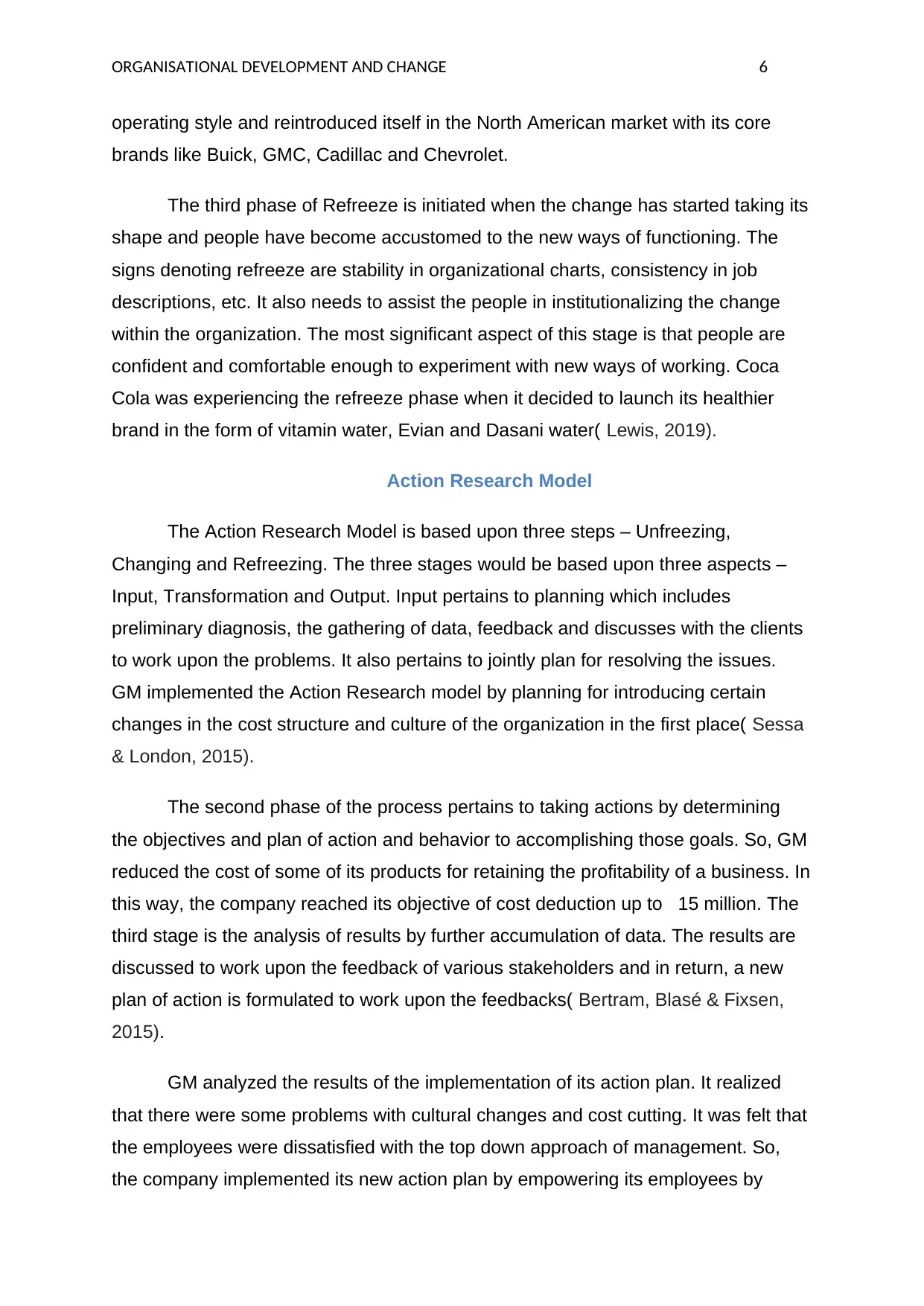
ORGANISATIONAL DEVELOPMENT AND CHANGE 6
operating style and reintroduced itself in the North American market with its core
brands like Buick, GMC, Cadillac and Chevrolet.
The third phase of Refreeze is initiated when the change has started taking its
shape and people have become accustomed to the new ways of functioning. The
signs denoting refreeze are stability in organizational charts, consistency in job
descriptions, etc. It also needs to assist the people in institutionalizing the change
within the organization. The most significant aspect of this stage is that people are
confident and comfortable enough to experiment with new ways of working. Coca
Cola was experiencing the refreeze phase when it decided to launch its healthier
brand in the form of vitamin water, Evian and Dasani water( Lewis, 2019).
Action Research Model
The Action Research Model is based upon three steps – Unfreezing,
Changing and Refreezing. The three stages would be based upon three aspects –
Input, Transformation and Output. Input pertains to planning which includes
preliminary diagnosis, the gathering of data, feedback and discusses with the clients
to work upon the problems. It also pertains to jointly plan for resolving the issues.
GM implemented the Action Research model by planning for introducing certain
changes in the cost structure and culture of the organization in the first place( Sessa
& London, 2015).
The second phase of the process pertains to taking actions by determining
the objectives and plan of action and behavior to accomplishing those goals. So, GM
reduced the cost of some of its products for retaining the profitability of a business. In
this way, the company reached its objective of cost deduction up to 15 million. The
third stage is the analysis of results by further accumulation of data. The results are
discussed to work upon the feedback of various stakeholders and in return, a new
plan of action is formulated to work upon the feedbacks( Bertram, Blasé & Fixsen,
2015).
GM analyzed the results of the implementation of its action plan. It realized
that there were some problems with cultural changes and cost cutting. It was felt that
the employees were dissatisfied with the top down approach of management. So,
the company implemented its new action plan by empowering its employees by
operating style and reintroduced itself in the North American market with its core
brands like Buick, GMC, Cadillac and Chevrolet.
The third phase of Refreeze is initiated when the change has started taking its
shape and people have become accustomed to the new ways of functioning. The
signs denoting refreeze are stability in organizational charts, consistency in job
descriptions, etc. It also needs to assist the people in institutionalizing the change
within the organization. The most significant aspect of this stage is that people are
confident and comfortable enough to experiment with new ways of working. Coca
Cola was experiencing the refreeze phase when it decided to launch its healthier
brand in the form of vitamin water, Evian and Dasani water( Lewis, 2019).
Action Research Model
The Action Research Model is based upon three steps – Unfreezing,
Changing and Refreezing. The three stages would be based upon three aspects –
Input, Transformation and Output. Input pertains to planning which includes
preliminary diagnosis, the gathering of data, feedback and discusses with the clients
to work upon the problems. It also pertains to jointly plan for resolving the issues.
GM implemented the Action Research model by planning for introducing certain
changes in the cost structure and culture of the organization in the first place( Sessa
& London, 2015).
The second phase of the process pertains to taking actions by determining
the objectives and plan of action and behavior to accomplishing those goals. So, GM
reduced the cost of some of its products for retaining the profitability of a business. In
this way, the company reached its objective of cost deduction up to 15 million. The
third stage is the analysis of results by further accumulation of data. The results are
discussed to work upon the feedback of various stakeholders and in return, a new
plan of action is formulated to work upon the feedbacks( Bertram, Blasé & Fixsen,
2015).
GM analyzed the results of the implementation of its action plan. It realized
that there were some problems with cultural changes and cost cutting. It was felt that
the employees were dissatisfied with the top down approach of management. So,
the company implemented its new action plan by empowering its employees by
Paraphrase This Document
Need a fresh take? Get an instant paraphrase of this document with our AI Paraphraser
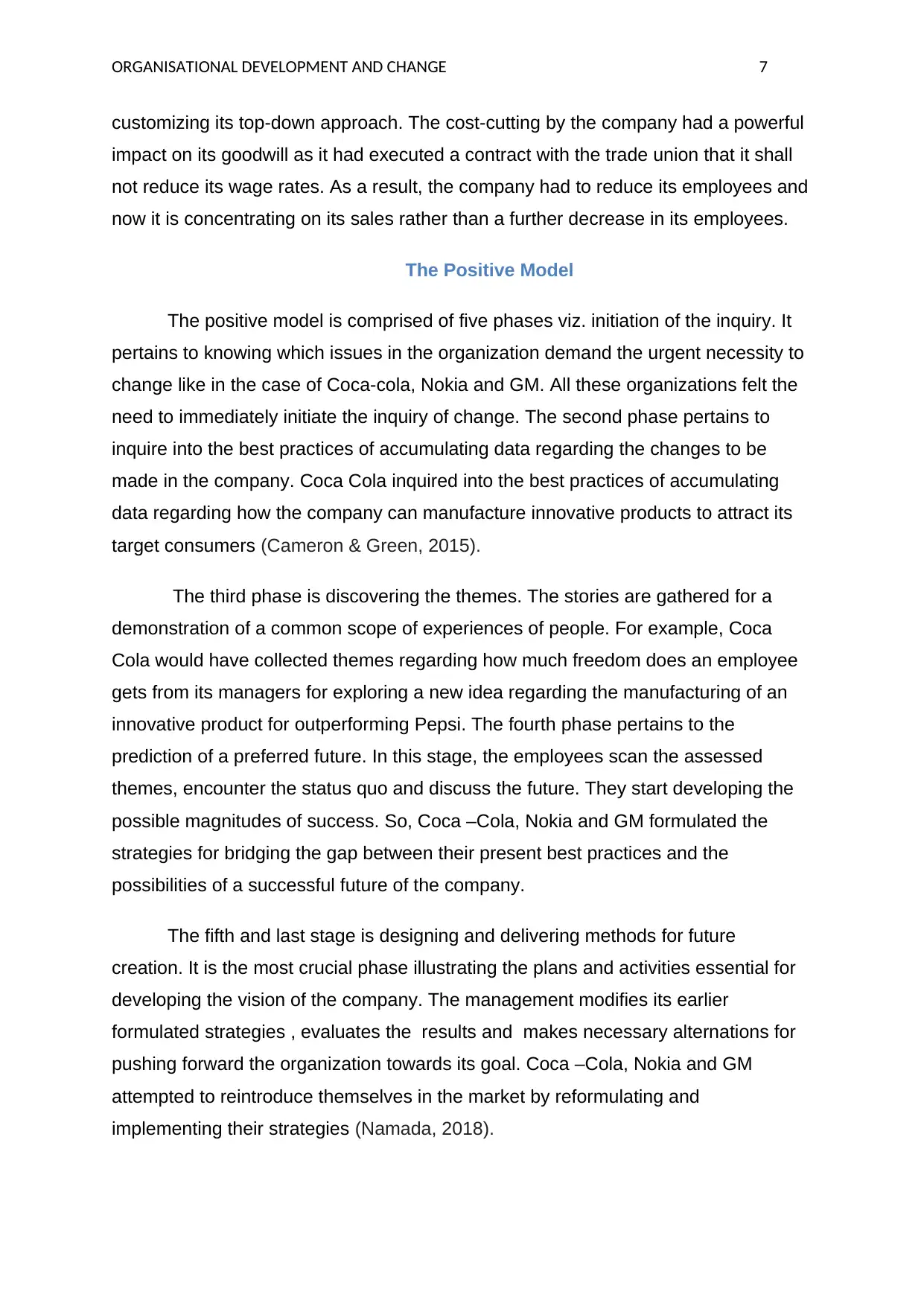
ORGANISATIONAL DEVELOPMENT AND CHANGE 7
customizing its top-down approach. The cost-cutting by the company had a powerful
impact on its goodwill as it had executed a contract with the trade union that it shall
not reduce its wage rates. As a result, the company had to reduce its employees and
now it is concentrating on its sales rather than a further decrease in its employees.
The Positive Model
The positive model is comprised of five phases viz. initiation of the inquiry. It
pertains to knowing which issues in the organization demand the urgent necessity to
change like in the case of Coca-cola, Nokia and GM. All these organizations felt the
need to immediately initiate the inquiry of change. The second phase pertains to
inquire into the best practices of accumulating data regarding the changes to be
made in the company. Coca Cola inquired into the best practices of accumulating
data regarding how the company can manufacture innovative products to attract its
target consumers (Cameron & Green, 2015).
The third phase is discovering the themes. The stories are gathered for a
demonstration of a common scope of experiences of people. For example, Coca
Cola would have collected themes regarding how much freedom does an employee
gets from its managers for exploring a new idea regarding the manufacturing of an
innovative product for outperforming Pepsi. The fourth phase pertains to the
prediction of a preferred future. In this stage, the employees scan the assessed
themes, encounter the status quo and discuss the future. They start developing the
possible magnitudes of success. So, Coca –Cola, Nokia and GM formulated the
strategies for bridging the gap between their present best practices and the
possibilities of a successful future of the company.
The fifth and last stage is designing and delivering methods for future
creation. It is the most crucial phase illustrating the plans and activities essential for
developing the vision of the company. The management modifies its earlier
formulated strategies , evaluates the results and makes necessary alternations for
pushing forward the organization towards its goal. Coca –Cola, Nokia and GM
attempted to reintroduce themselves in the market by reformulating and
implementing their strategies (Namada, 2018).
customizing its top-down approach. The cost-cutting by the company had a powerful
impact on its goodwill as it had executed a contract with the trade union that it shall
not reduce its wage rates. As a result, the company had to reduce its employees and
now it is concentrating on its sales rather than a further decrease in its employees.
The Positive Model
The positive model is comprised of five phases viz. initiation of the inquiry. It
pertains to knowing which issues in the organization demand the urgent necessity to
change like in the case of Coca-cola, Nokia and GM. All these organizations felt the
need to immediately initiate the inquiry of change. The second phase pertains to
inquire into the best practices of accumulating data regarding the changes to be
made in the company. Coca Cola inquired into the best practices of accumulating
data regarding how the company can manufacture innovative products to attract its
target consumers (Cameron & Green, 2015).
The third phase is discovering the themes. The stories are gathered for a
demonstration of a common scope of experiences of people. For example, Coca
Cola would have collected themes regarding how much freedom does an employee
gets from its managers for exploring a new idea regarding the manufacturing of an
innovative product for outperforming Pepsi. The fourth phase pertains to the
prediction of a preferred future. In this stage, the employees scan the assessed
themes, encounter the status quo and discuss the future. They start developing the
possible magnitudes of success. So, Coca –Cola, Nokia and GM formulated the
strategies for bridging the gap between their present best practices and the
possibilities of a successful future of the company.
The fifth and last stage is designing and delivering methods for future
creation. It is the most crucial phase illustrating the plans and activities essential for
developing the vision of the company. The management modifies its earlier
formulated strategies , evaluates the results and makes necessary alternations for
pushing forward the organization towards its goal. Coca –Cola, Nokia and GM
attempted to reintroduce themselves in the market by reformulating and
implementing their strategies (Namada, 2018).
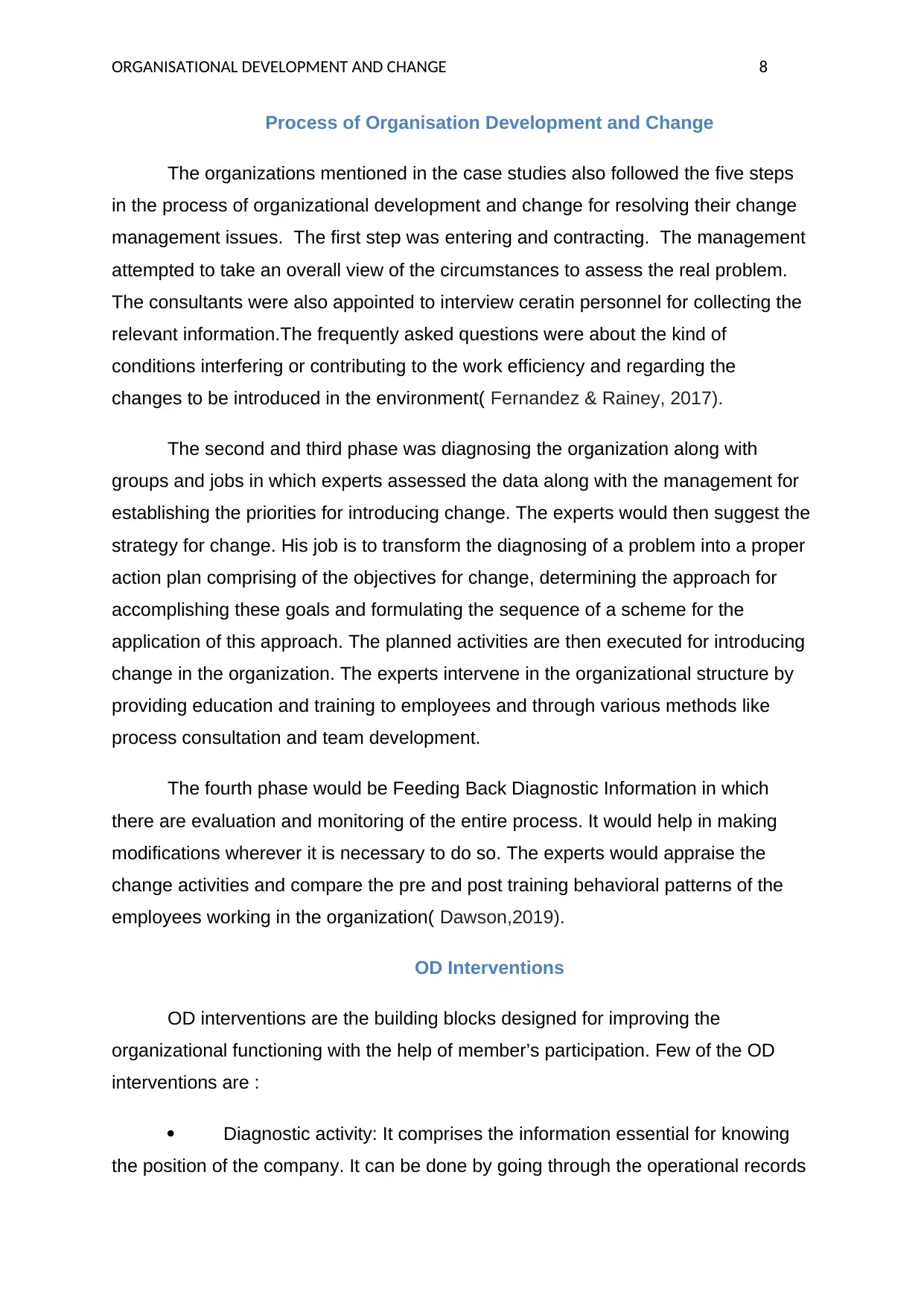
ORGANISATIONAL DEVELOPMENT AND CHANGE 8
Process of Organisation Development and Change
The organizations mentioned in the case studies also followed the five steps
in the process of organizational development and change for resolving their change
management issues. The first step was entering and contracting. The management
attempted to take an overall view of the circumstances to assess the real problem.
The consultants were also appointed to interview ceratin personnel for collecting the
relevant information.The frequently asked questions were about the kind of
conditions interfering or contributing to the work efficiency and regarding the
changes to be introduced in the environment( Fernandez & Rainey, 2017).
The second and third phase was diagnosing the organization along with
groups and jobs in which experts assessed the data along with the management for
establishing the priorities for introducing change. The experts would then suggest the
strategy for change. His job is to transform the diagnosing of a problem into a proper
action plan comprising of the objectives for change, determining the approach for
accomplishing these goals and formulating the sequence of a scheme for the
application of this approach. The planned activities are then executed for introducing
change in the organization. The experts intervene in the organizational structure by
providing education and training to employees and through various methods like
process consultation and team development.
The fourth phase would be Feeding Back Diagnostic Information in which
there are evaluation and monitoring of the entire process. It would help in making
modifications wherever it is necessary to do so. The experts would appraise the
change activities and compare the pre and post training behavioral patterns of the
employees working in the organization( Dawson,2019).
OD Interventions
OD interventions are the building blocks designed for improving the
organizational functioning with the help of member’s participation. Few of the OD
interventions are :
Diagnostic activity: It comprises the information essential for knowing
the position of the company. It can be done by going through the operational records
Process of Organisation Development and Change
The organizations mentioned in the case studies also followed the five steps
in the process of organizational development and change for resolving their change
management issues. The first step was entering and contracting. The management
attempted to take an overall view of the circumstances to assess the real problem.
The consultants were also appointed to interview ceratin personnel for collecting the
relevant information.The frequently asked questions were about the kind of
conditions interfering or contributing to the work efficiency and regarding the
changes to be introduced in the environment( Fernandez & Rainey, 2017).
The second and third phase was diagnosing the organization along with
groups and jobs in which experts assessed the data along with the management for
establishing the priorities for introducing change. The experts would then suggest the
strategy for change. His job is to transform the diagnosing of a problem into a proper
action plan comprising of the objectives for change, determining the approach for
accomplishing these goals and formulating the sequence of a scheme for the
application of this approach. The planned activities are then executed for introducing
change in the organization. The experts intervene in the organizational structure by
providing education and training to employees and through various methods like
process consultation and team development.
The fourth phase would be Feeding Back Diagnostic Information in which
there are evaluation and monitoring of the entire process. It would help in making
modifications wherever it is necessary to do so. The experts would appraise the
change activities and compare the pre and post training behavioral patterns of the
employees working in the organization( Dawson,2019).
OD Interventions
OD interventions are the building blocks designed for improving the
organizational functioning with the help of member’s participation. Few of the OD
interventions are :
Diagnostic activity: It comprises the information essential for knowing
the position of the company. It can be done by going through the operational records
⊘ This is a preview!⊘
Do you want full access?
Subscribe today to unlock all pages.

Trusted by 1+ million students worldwide
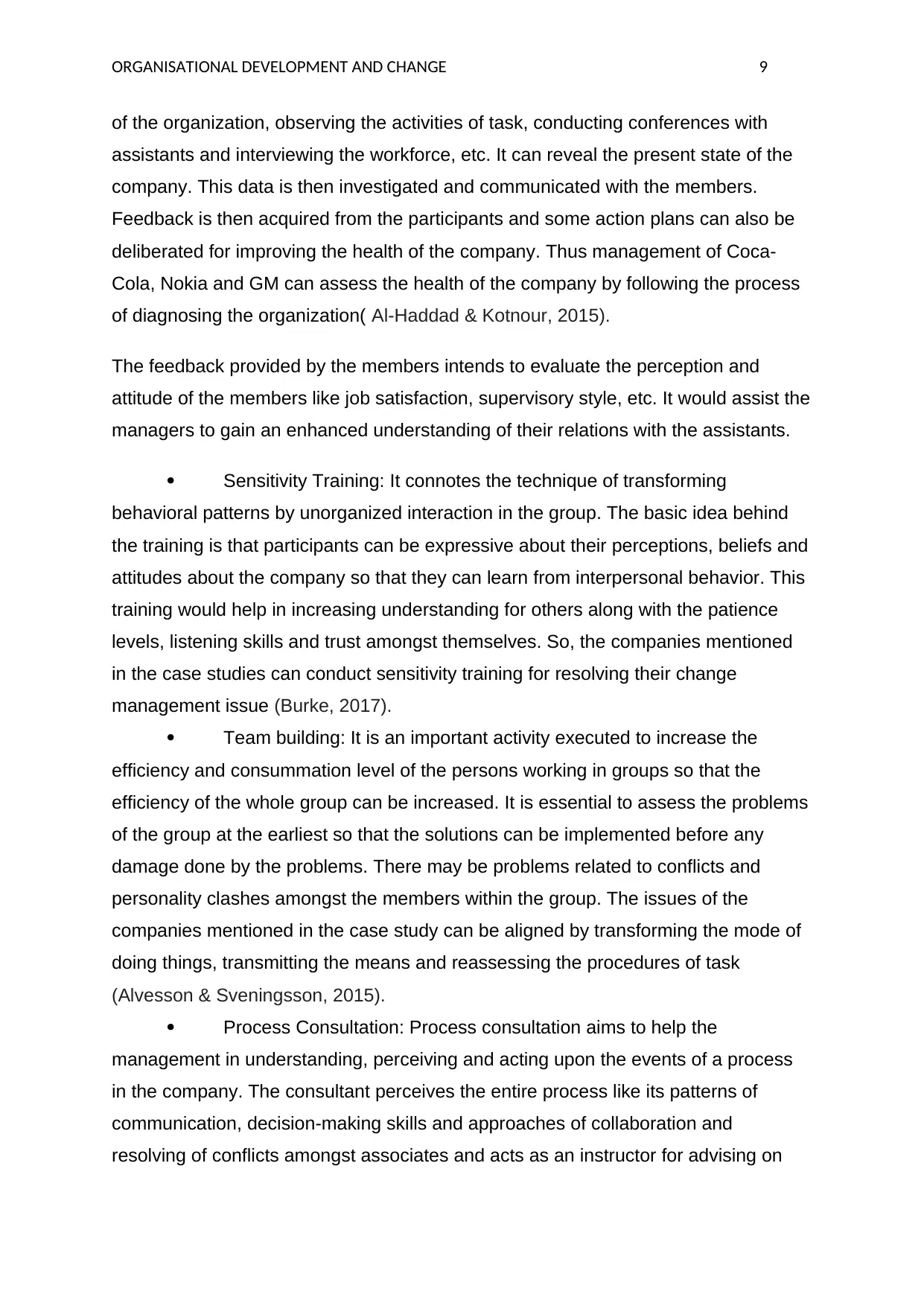
ORGANISATIONAL DEVELOPMENT AND CHANGE 9
of the organization, observing the activities of task, conducting conferences with
assistants and interviewing the workforce, etc. It can reveal the present state of the
company. This data is then investigated and communicated with the members.
Feedback is then acquired from the participants and some action plans can also be
deliberated for improving the health of the company. Thus management of Coca-
Cola, Nokia and GM can assess the health of the company by following the process
of diagnosing the organization( Al-Haddad & Kotnour, 2015).
The feedback provided by the members intends to evaluate the perception and
attitude of the members like job satisfaction, supervisory style, etc. It would assist the
managers to gain an enhanced understanding of their relations with the assistants.
Sensitivity Training: It connotes the technique of transforming
behavioral patterns by unorganized interaction in the group. The basic idea behind
the training is that participants can be expressive about their perceptions, beliefs and
attitudes about the company so that they can learn from interpersonal behavior. This
training would help in increasing understanding for others along with the patience
levels, listening skills and trust amongst themselves. So, the companies mentioned
in the case studies can conduct sensitivity training for resolving their change
management issue (Burke, 2017).
Team building: It is an important activity executed to increase the
efficiency and consummation level of the persons working in groups so that the
efficiency of the whole group can be increased. It is essential to assess the problems
of the group at the earliest so that the solutions can be implemented before any
damage done by the problems. There may be problems related to conflicts and
personality clashes amongst the members within the group. The issues of the
companies mentioned in the case study can be aligned by transforming the mode of
doing things, transmitting the means and reassessing the procedures of task
(Alvesson & Sveningsson, 2015).
Process Consultation: Process consultation aims to help the
management in understanding, perceiving and acting upon the events of a process
in the company. The consultant perceives the entire process like its patterns of
communication, decision-making skills and approaches of collaboration and
resolving of conflicts amongst associates and acts as an instructor for advising on
of the organization, observing the activities of task, conducting conferences with
assistants and interviewing the workforce, etc. It can reveal the present state of the
company. This data is then investigated and communicated with the members.
Feedback is then acquired from the participants and some action plans can also be
deliberated for improving the health of the company. Thus management of Coca-
Cola, Nokia and GM can assess the health of the company by following the process
of diagnosing the organization( Al-Haddad & Kotnour, 2015).
The feedback provided by the members intends to evaluate the perception and
attitude of the members like job satisfaction, supervisory style, etc. It would assist the
managers to gain an enhanced understanding of their relations with the assistants.
Sensitivity Training: It connotes the technique of transforming
behavioral patterns by unorganized interaction in the group. The basic idea behind
the training is that participants can be expressive about their perceptions, beliefs and
attitudes about the company so that they can learn from interpersonal behavior. This
training would help in increasing understanding for others along with the patience
levels, listening skills and trust amongst themselves. So, the companies mentioned
in the case studies can conduct sensitivity training for resolving their change
management issue (Burke, 2017).
Team building: It is an important activity executed to increase the
efficiency and consummation level of the persons working in groups so that the
efficiency of the whole group can be increased. It is essential to assess the problems
of the group at the earliest so that the solutions can be implemented before any
damage done by the problems. There may be problems related to conflicts and
personality clashes amongst the members within the group. The issues of the
companies mentioned in the case study can be aligned by transforming the mode of
doing things, transmitting the means and reassessing the procedures of task
(Alvesson & Sveningsson, 2015).
Process Consultation: Process consultation aims to help the
management in understanding, perceiving and acting upon the events of a process
in the company. The consultant perceives the entire process like its patterns of
communication, decision-making skills and approaches of collaboration and
resolving of conflicts amongst associates and acts as an instructor for advising on
Paraphrase This Document
Need a fresh take? Get an instant paraphrase of this document with our AI Paraphraser
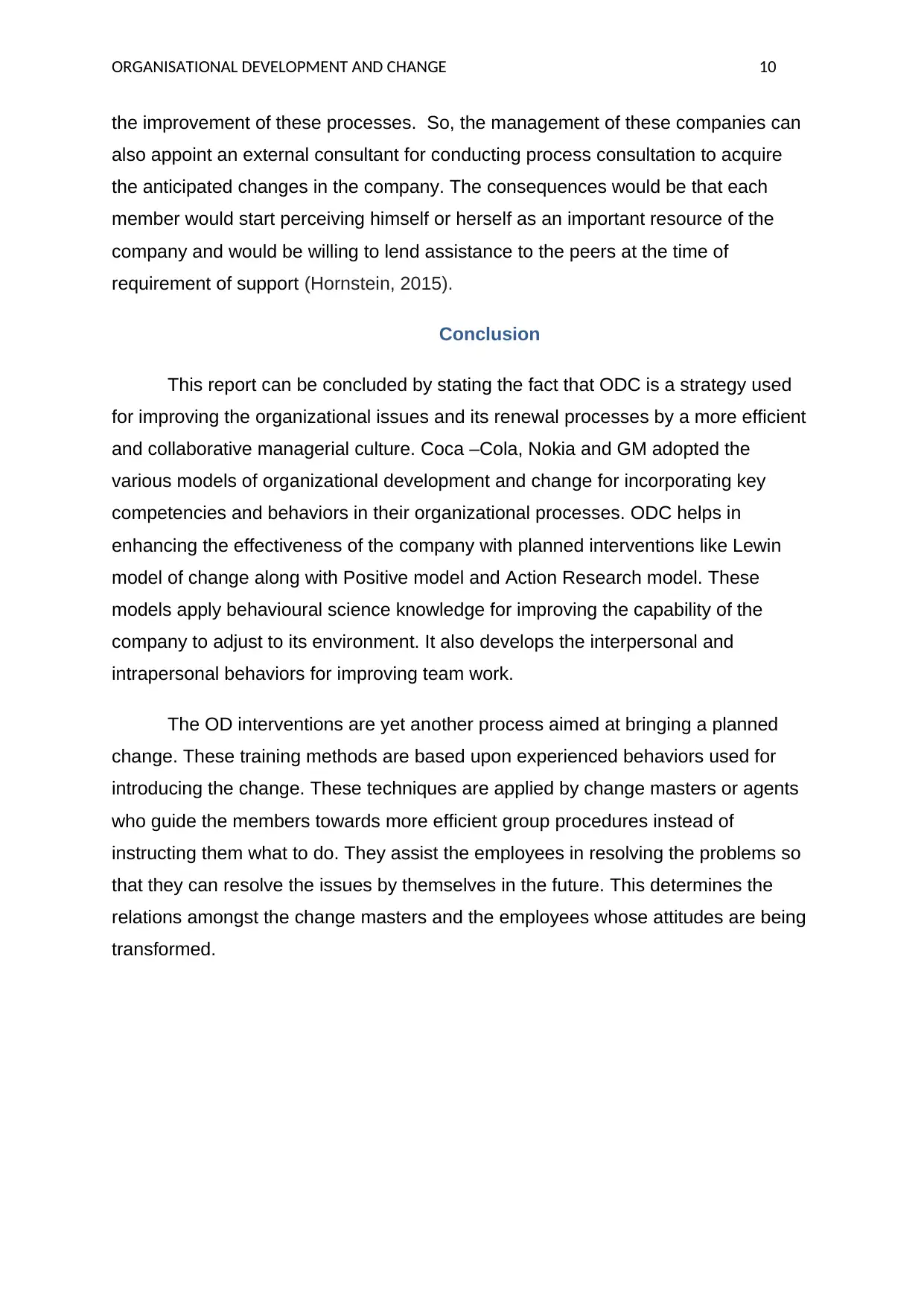
ORGANISATIONAL DEVELOPMENT AND CHANGE 10
the improvement of these processes. So, the management of these companies can
also appoint an external consultant for conducting process consultation to acquire
the anticipated changes in the company. The consequences would be that each
member would start perceiving himself or herself as an important resource of the
company and would be willing to lend assistance to the peers at the time of
requirement of support (Hornstein, 2015).
Conclusion
This report can be concluded by stating the fact that ODC is a strategy used
for improving the organizational issues and its renewal processes by a more efficient
and collaborative managerial culture. Coca –Cola, Nokia and GM adopted the
various models of organizational development and change for incorporating key
competencies and behaviors in their organizational processes. ODC helps in
enhancing the effectiveness of the company with planned interventions like Lewin
model of change along with Positive model and Action Research model. These
models apply behavioural science knowledge for improving the capability of the
company to adjust to its environment. It also develops the interpersonal and
intrapersonal behaviors for improving team work.
The OD interventions are yet another process aimed at bringing a planned
change. These training methods are based upon experienced behaviors used for
introducing the change. These techniques are applied by change masters or agents
who guide the members towards more efficient group procedures instead of
instructing them what to do. They assist the employees in resolving the problems so
that they can resolve the issues by themselves in the future. This determines the
relations amongst the change masters and the employees whose attitudes are being
transformed.
the improvement of these processes. So, the management of these companies can
also appoint an external consultant for conducting process consultation to acquire
the anticipated changes in the company. The consequences would be that each
member would start perceiving himself or herself as an important resource of the
company and would be willing to lend assistance to the peers at the time of
requirement of support (Hornstein, 2015).
Conclusion
This report can be concluded by stating the fact that ODC is a strategy used
for improving the organizational issues and its renewal processes by a more efficient
and collaborative managerial culture. Coca –Cola, Nokia and GM adopted the
various models of organizational development and change for incorporating key
competencies and behaviors in their organizational processes. ODC helps in
enhancing the effectiveness of the company with planned interventions like Lewin
model of change along with Positive model and Action Research model. These
models apply behavioural science knowledge for improving the capability of the
company to adjust to its environment. It also develops the interpersonal and
intrapersonal behaviors for improving team work.
The OD interventions are yet another process aimed at bringing a planned
change. These training methods are based upon experienced behaviors used for
introducing the change. These techniques are applied by change masters or agents
who guide the members towards more efficient group procedures instead of
instructing them what to do. They assist the employees in resolving the problems so
that they can resolve the issues by themselves in the future. This determines the
relations amongst the change masters and the employees whose attitudes are being
transformed.
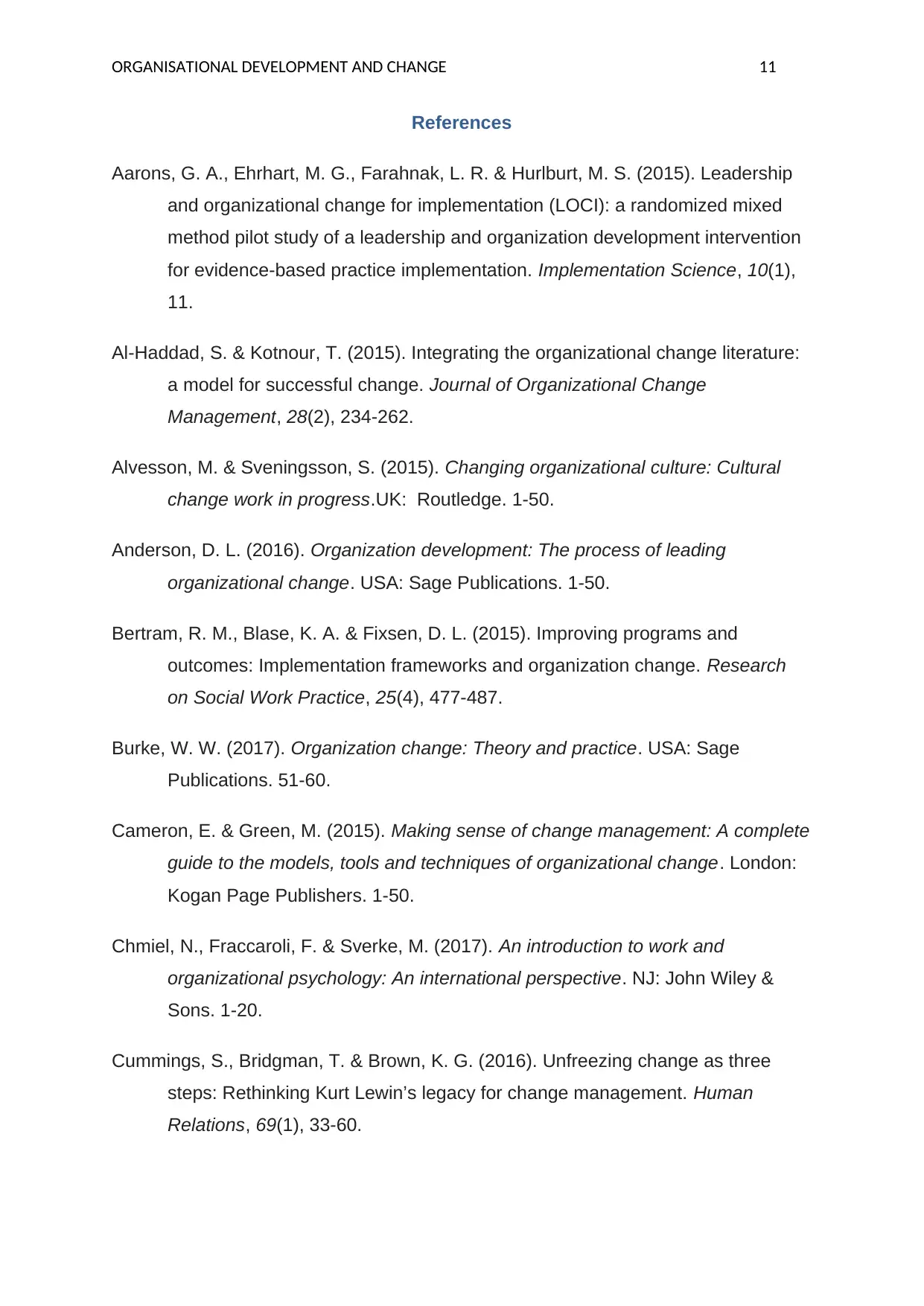
ORGANISATIONAL DEVELOPMENT AND CHANGE 11
References
Aarons, G. A., Ehrhart, M. G., Farahnak, L. R. & Hurlburt, M. S. (2015). Leadership
and organizational change for implementation (LOCI): a randomized mixed
method pilot study of a leadership and organization development intervention
for evidence-based practice implementation. Implementation Science, 10(1),
11.
Al-Haddad, S. & Kotnour, T. (2015). Integrating the organizational change literature:
a model for successful change. Journal of Organizational Change
Management, 28(2), 234-262.
Alvesson, M. & Sveningsson, S. (2015). Changing organizational culture: Cultural
change work in progress.UK: Routledge. 1-50.
Anderson, D. L. (2016). Organization development: The process of leading
organizational change. USA: Sage Publications. 1-50.
Bertram, R. M., Blase, K. A. & Fixsen, D. L. (2015). Improving programs and
outcomes: Implementation frameworks and organization change. Research
on Social Work Practice, 25(4), 477-487.
Burke, W. W. (2017). Organization change: Theory and practice. USA: Sage
Publications. 51-60.
Cameron, E. & Green, M. (2015). Making sense of change management: A complete
guide to the models, tools and techniques of organizational change. London:
Kogan Page Publishers. 1-50.
Chmiel, N., Fraccaroli, F. & Sverke, M. (2017). An introduction to work and
organizational psychology: An international perspective. NJ: John Wiley &
Sons. 1-20.
Cummings, S., Bridgman, T. & Brown, K. G. (2016). Unfreezing change as three
steps: Rethinking Kurt Lewin’s legacy for change management. Human
Relations, 69(1), 33-60.
References
Aarons, G. A., Ehrhart, M. G., Farahnak, L. R. & Hurlburt, M. S. (2015). Leadership
and organizational change for implementation (LOCI): a randomized mixed
method pilot study of a leadership and organization development intervention
for evidence-based practice implementation. Implementation Science, 10(1),
11.
Al-Haddad, S. & Kotnour, T. (2015). Integrating the organizational change literature:
a model for successful change. Journal of Organizational Change
Management, 28(2), 234-262.
Alvesson, M. & Sveningsson, S. (2015). Changing organizational culture: Cultural
change work in progress.UK: Routledge. 1-50.
Anderson, D. L. (2016). Organization development: The process of leading
organizational change. USA: Sage Publications. 1-50.
Bertram, R. M., Blase, K. A. & Fixsen, D. L. (2015). Improving programs and
outcomes: Implementation frameworks and organization change. Research
on Social Work Practice, 25(4), 477-487.
Burke, W. W. (2017). Organization change: Theory and practice. USA: Sage
Publications. 51-60.
Cameron, E. & Green, M. (2015). Making sense of change management: A complete
guide to the models, tools and techniques of organizational change. London:
Kogan Page Publishers. 1-50.
Chmiel, N., Fraccaroli, F. & Sverke, M. (2017). An introduction to work and
organizational psychology: An international perspective. NJ: John Wiley &
Sons. 1-20.
Cummings, S., Bridgman, T. & Brown, K. G. (2016). Unfreezing change as three
steps: Rethinking Kurt Lewin’s legacy for change management. Human
Relations, 69(1), 33-60.
⊘ This is a preview!⊘
Do you want full access?
Subscribe today to unlock all pages.

Trusted by 1+ million students worldwide
1 out of 13
Related Documents
Your All-in-One AI-Powered Toolkit for Academic Success.
+13062052269
info@desklib.com
Available 24*7 on WhatsApp / Email
![[object Object]](/_next/static/media/star-bottom.7253800d.svg)
Unlock your academic potential
Copyright © 2020–2025 A2Z Services. All Rights Reserved. Developed and managed by ZUCOL.





